A Novel Reactive Power Optimization in Distribution Network Based on Typical Scenarios Partitioning and Load Distribution Matching Method
Abstract
:Featured Application
Abstract
1. Introduction
2. The Method of Typical Scenarios Partitioning and Load Distribution Matching
2.1. Relationship between the Data Source and the Optimal Schemes in Reactive Power Optimization
2.2. The Method of Typical Scenarios Partitioning
2.3. The Method of Load Distribution Matching
3. Reactive Power Optimization in Distribution Network Based on EWOSM
3.1. Introduction to Multi-Attribute Decision Making Problem Based on Entropy Weight Method
3.2. Specific Steps of EWOSM
4. Case Study
4.1. A Practical Distribution System with 173 Nodes
4.1.1. Case Descriptions of the 173 Nodes System
4.1.2. The Typical Scenarios Partitioning of the 173 Nodes System
4.1.3. The Load Distribution Matching of the 173 Nodes System
4.1.4. The Entropy Weight Method of the 173 Nodes System
4.1.5. Results, Comparisons and Analysis of the 173 Nodes System
4.2. The Influence of System Scale and the Number of Control Variables on the Computation Time
4.2.1. Analysis of the Influence of System Scale on the Computation Time
4.2.2. Analysis of the Influence of the Number of Control Variables on the Computation Time
4.3. The Combination of EWOSM and SQP Method
5. Conclusions
- (1)
- The proposed EWOSM can rapidly and accurately select out the optimal scheme from large amount of historical data. And the advantage in computation time is remarkable than existing methods.
- (2)
- The proposed EWOSM can be used in combination with existing methods to speed up the convergence and ensure the global optimization.
- (3)
- As the proposed EWOSM is based on the analysis of large amount of historical data, it is more suitable for the distribution system that has relatively stable load and complete historical database; otherwise the proposed EWOSM needs to cooperate with existing methods. The application of big data theory and method in reactive power optimization needs to be further improved and perfected.
Acknowledgments
Author Contributions
Conflicts of Interest
Appendix A. The Calculation Results of Three Methods with Different Scales of Systems
| IEEE 33 Nodes System | PG&E 69 Nodes System | 292 Nodes System | ||||||||
|---|---|---|---|---|---|---|---|---|---|---|
| EWOSM | GA | SQP | EWOSM | GA | SQP | EWOSM | GA | SQP | ||
| Optimal scheme | C1/kvar | 300 | 300 | 300 | 300 | 300 | 300 | 750 | 750 | 750 |
| C2/kvar | 400 | 400 | 400 | 1000 | 1050 | 1050 | 300 | 300 | 300 | |
| C3/kvar | 800 | 800 | 800 | 200 | 200 | 200 | 400 | 400 | 400 | |
| T | 1 + 4 × 1.25% | 1 + 4 × 1.25% | 1 + 4 × 1.25% | |||||||
| Network loss/kW | 75.5 | 75.5 | 75.5 | 124.8 | 124.7 | 124.7 | 93.8 | 93.8 | 93.8 | |
| Node voltage offset | 1.27 | 1.27 | 1.27 | 4.49 | 4.50 | 4.50 | 8.69 | 8.69 | 8.69 | |
| Minimum module-eigenvalue | 0.0169 | 0.0169 | 0.0169 | 0.00991 | 0.00992 | 0.00992 | 0.00155 | 0.00155 | 0.00155 | |
| Computation time/s | 1.08 | 23.15 | 2.48 | 1.67 | 32.13 | 3.21 | 1.87 | 49.49 | 2.36 | |
References
- Zhang, B.; Hou, P.; Hu, W.; Soltani, M.; Chen, C.; Chen, Z. A reactive power dispatch strategy with loss minimization for a DFIG-based wind farm. IEEE Trans. Sustain. Energy 2016, 7, 914–923. [Google Scholar] [CrossRef]
- Chavez, D.; Espinosa, S.; Cazco, D.A. Reactive power optimization of the electric system based on minimization of losses. IEEE Trans. Smart Grid 2016, 14, 4540–4546. [Google Scholar] [CrossRef]
- Xue, Y.; Zhang, X.P. Reactive power and AC voltage control of LCC HVDC system with controllable capacitors. IEEE Trans. Power Syst. 2017, 32, 753–764. [Google Scholar] [CrossRef]
- Garcia, A.M.; Mastromauro, R.A.; Sanchez, T.G.; Pugliese, S.; Liserre, M.; Stasi, S. Reactive power flow control for PV inverters voltage support in LV distribution networks. IEEE Trans. Smart Grid 2017, 8, 447–456. [Google Scholar] [CrossRef]
- Nie, Y.; Du, Z.; Li, J. AC–DC optimal reactive power flow model via predictor–corrector primal-dual interior-point method. IET Gener. Transm. Distrib. 2013, 7, 382–390. [Google Scholar] [CrossRef]
- Abril, I.P.; Quintero, J.A.G. VAr compensation by sequential quadratic programming. IEEE Trans. Power Syst. 2003, 18, 36–41. [Google Scholar] [CrossRef]
- Zhang, C.; Chen, H.; Ngan, H. Reactive power optimisation considering wind farms based on an optimal scenario method. IET Gener. Transm. Distrib. 2016, 10, 3736–3744. [Google Scholar] [CrossRef]
- Chen, S.; Hu, W.; Chen, Z. Comprehensive cost minimization in distribution networks using segmented-time feeder reconfiguration and reactive power control of distributed generators. IEEE Trans. Power Syst. 2016, 31, 983–993. [Google Scholar] [CrossRef]
- Chen, F.; Chen, M.; Li, Q.; Meng, K.; Guerrero, J.M.; Abbott, D. Multiagent-based reactive power sharing and control model for islanded microgrids. IEEE Trans. Sustain. Energy 2016, 7, 1232–1244. [Google Scholar] [CrossRef]
- Cimino, M.; Pagilla, P.R. Reactive power control for multiple synchronous generators connected in parallel. IEEE Trans. Power Syst. 2016, 31, 4371–4378. [Google Scholar] [CrossRef]
- Lin, C.; Wu, W.; Zhang, B.; Wang, B.; Zheng, W.; Li, Z. Decentralized reactive power optimization method for transmission and distribution networks accommodating large-scale DG integration. IEEE Trans. Sustain. Energy 2017, 8, 363–373. [Google Scholar] [CrossRef]
- Ding, T.; Liu, S.; Wu, Z.; Bie, Z. Sensitivity-based relaxation and decomposition method to dynamic reactive power optimisation considering DGs in active distribution networks. IET Gener. Transm. Distrib. 2017, 11, 37–48. [Google Scholar] [CrossRef]
- Salih, S.N.; Chen, P. On coordinated control of OLTC and reactive power compensation for voltage regulation in distribution systems with wind power. IEEE Trans. Power Syst. 2016, 31, 4026–4035. [Google Scholar] [CrossRef]
- Sheng, W.; Liu, K.Y.; Liu, Y.; Ye, X.; He, K. Reactive power coordinated optimisation method with renewable distributed generation based on improved harmony search. IET Gener. Transm. Distrib. 2016, 10, 3152–3162. [Google Scholar] [CrossRef]
- Ugranli, F.; Karatepe, E.; Nielsen, A.H. MILP approach for bilevel transmission and reactive power planning considering wind curtailment. IEEE Trans. Power Syst. 2017, 32, 652–661. [Google Scholar] [CrossRef]
- Edrah, M.; Lo, K.L.; Anaya-Lara, O. Reactive power control of DFIG wind turbines for power oscillation damping under a wide range of operating conditions. IET Gener. Transm. Distrib. 2016, 10, 3777–3785. [Google Scholar] [CrossRef]
- Robbins, B.A.; Domínguez-García, A.D. Optimal reactive power dispatch for voltage regulation in unbalanced distribution systems. IEEE Trans. Power Syst. 2016, 31, 2903–2913. [Google Scholar] [CrossRef]
- Yang, F.; Li, Z. Improve distribution system energy efficiency with coordinated reactive power control. IEEE Trans. Power Syst. 2016, 31, 2518–2525. [Google Scholar] [CrossRef]
- Macedo, L.H.; Montes, C.V.; Franco, J.F.; Rider, M.J.; Romero, R. MILP branch flow model for concurrent AC multistage transmission expansion and reactive power planning with security constraints. IET Gener. Transm. Distrib. 2016, 10, 3023–3032. [Google Scholar] [CrossRef]
- Wu, X.; Zhu, X.; Wu, G.Q.; Ding, W. Data mining with big data. IEEE Trans. Knowl. Data Eng. 2014, 26, 97–107. [Google Scholar]
- Hu, H.; Wen, Y.; Chua, T.S.; Li, X. Toward scalable systems for big data analytics: A technology tutorial. IEEE Access 2014, 2, 652–687. [Google Scholar]
- Mao, B.; Jiang, H.; Wu, S.; Tian, L. Leveraging data deduplication to improve the performance of primary storage systems in the cloud. IEEE Trans. Comput. 2016, 65, 1775–1788. [Google Scholar] [CrossRef]
- Cherubini, G.; Jelitto, J.; Venkatesan, V. Cognitive storage for big data. Computer 2016, 49, 43–51. [Google Scholar] [CrossRef]
- Wang, B.; Fang, B.; Wang, Y.; Liu, H.; Liu, Y. Power system transient stability assessment based on big data and the core vector machine. IEEE Trans. Smart Grid 2016, 7, 2561–2570. [Google Scholar] [CrossRef]
- Peppanen, J.; Reno, M.J.; Broderick, R.J.; Grijalva, S. Distribution system model calibration with big data from AMI and PV inverters. IEEE Trans. Smart Grid 2016, 7, 2497–2506. [Google Scholar] [CrossRef]
- Zhu, J.; Zhuang, E.; Fu, J.; Baranowski, J.; Ford, A.; Shen, J. A framework-based approach to utility big data analytics. IEEE Trans. Power Syst. 2016, 31, 2455–2462. [Google Scholar] [CrossRef]
- Shaker, H.; Zareipour, H.; Wood, D. A data-driven approach for estimating the power generation of invisible solar sites. IEEE Trans. Smart Grid 2016, 7, 2466–2476. [Google Scholar] [CrossRef]
- Vaccaro, A.; Cañizares, C.A. An affine arithmetic-based framework for uncertain power flow and optimal power flow studies. IEEE Trans. Power Syst. 2017, 32, 274–288. [Google Scholar] [CrossRef]
- Pan, S.; Morris, T.; Adhikari, U. Developing a hybrid intrusion detection system using data mining for power systems. IEEE Trans. Smart Grid 2015, 6, 3104–3113. [Google Scholar] [CrossRef]
- Williams, T.; Crawford, C. Probabilistic load flow modeling comparing maximum entropy and gram-charlier probability density function reconstructions. IEEE Trans. Power Syst. 2013, 28, 272–280. [Google Scholar] [CrossRef]
- Samui, A.; Samantaray, S.R. Wavelet singular entropy-based islanding detection in distributed generation. IEEE Trans. Power Deliv. 2013, 28, 411–418. [Google Scholar] [CrossRef]
- Zhang, J.F.; Tse, C.T.; Wang, W.; Chung, C.Y. Voltage stability analysis based on probabilistic power flow and maximum entropy. IET Gener. Transm. Distrib. 2010, 4, 530–537. [Google Scholar] [CrossRef]
- Fu, J.; Fan, W.; Li, J.; Zhou, T.; Liu, B.; Chen, R. Study on information fusion method of distribution equipment condition comprehensive evaluation. In Proceedings of the China International Conference on Electricity Distribution, Xi’an, China, 10–13 August 2016. [Google Scholar]
- Diao, Y.; Sheng, W.; Liu, K.Y.; He, K.; Meng, X. Research on online cleaning and repair methods of large-scale distribution network load data. Power Syst. Technol. 2015, 3134–3140. [Google Scholar]
- Wang, M.; Wu, T. Load restoration optimization based on entropy weight method. In Proceedings of the International Conference on Power and Renewable Energy, Shanghai, China, 21–23 October 2016; IEEE: Piscataway, NJ, USA, 2016; pp. 368–372. [Google Scholar]
- Sheng, W.; Liu, K.Y.; Cheng, S.; Meng, X.; Dai, W. A trust region SQP method for coordinated voltage control in smart distribution grid. IEEE Trans. Smart Grid 2015, 7, 381–391. [Google Scholar] [CrossRef]
- Gong, C.; Wang, Z. Proficient in MATLAB Optimization Calculation, 2nd ed.; Publishing House of Electronics Industry: Beijing, China, 2012; pp. 314–318. [Google Scholar]
- Iba, K. Reactive power optimization by genetic algorithm. IEEE Trans. Power Syst. 1994, 9, 685–692. [Google Scholar]
- Baran, M.E.; Wu, F.F. Network reconfiguration in distribution systems for loss reduction and load balancing. IEEE Trans. Power Deliv. 1989, 4, 1401–1407. [Google Scholar] [CrossRef]
- Baran, M.E.; Wu, F.F. Optimal capacitor placement on radial distribution systems. IEEE Trans. Power Deliv. 1989, 4, 725–734. [Google Scholar] [CrossRef]
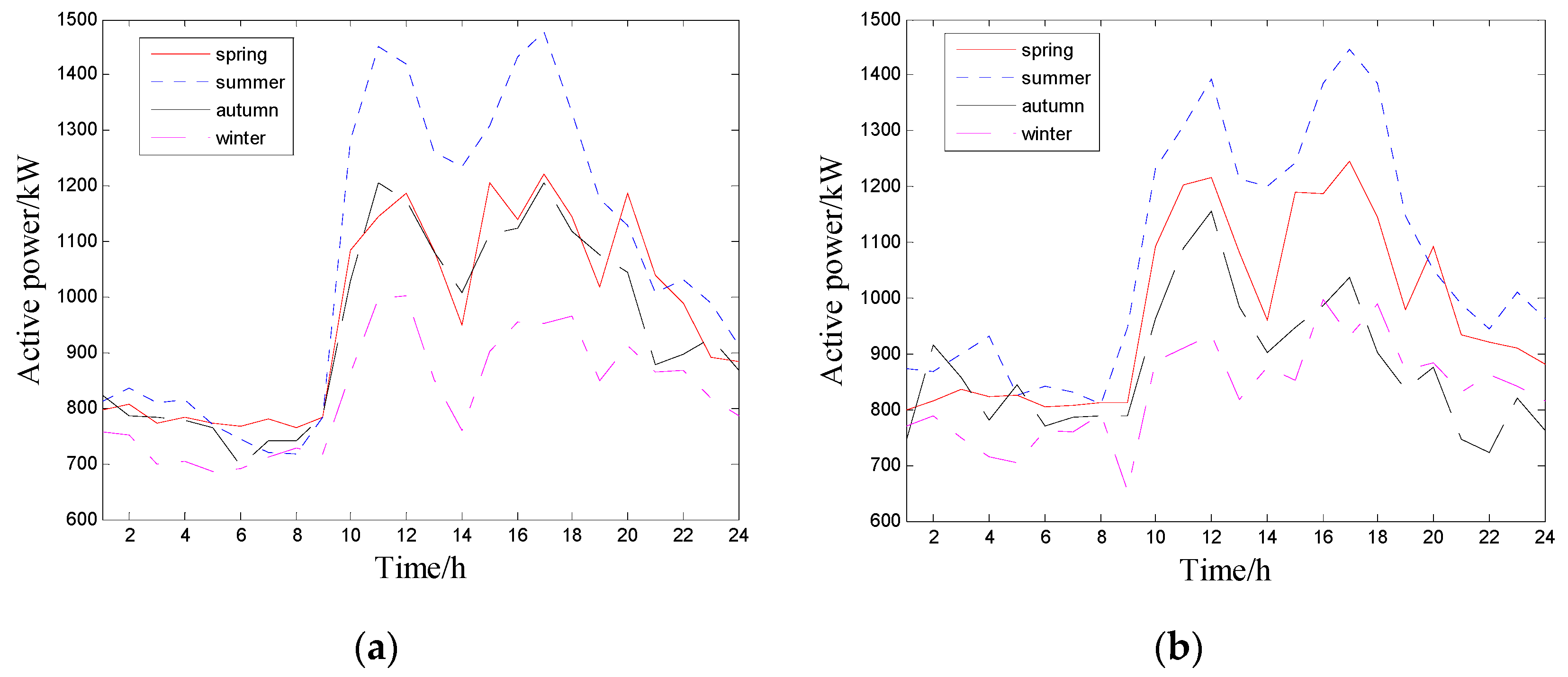



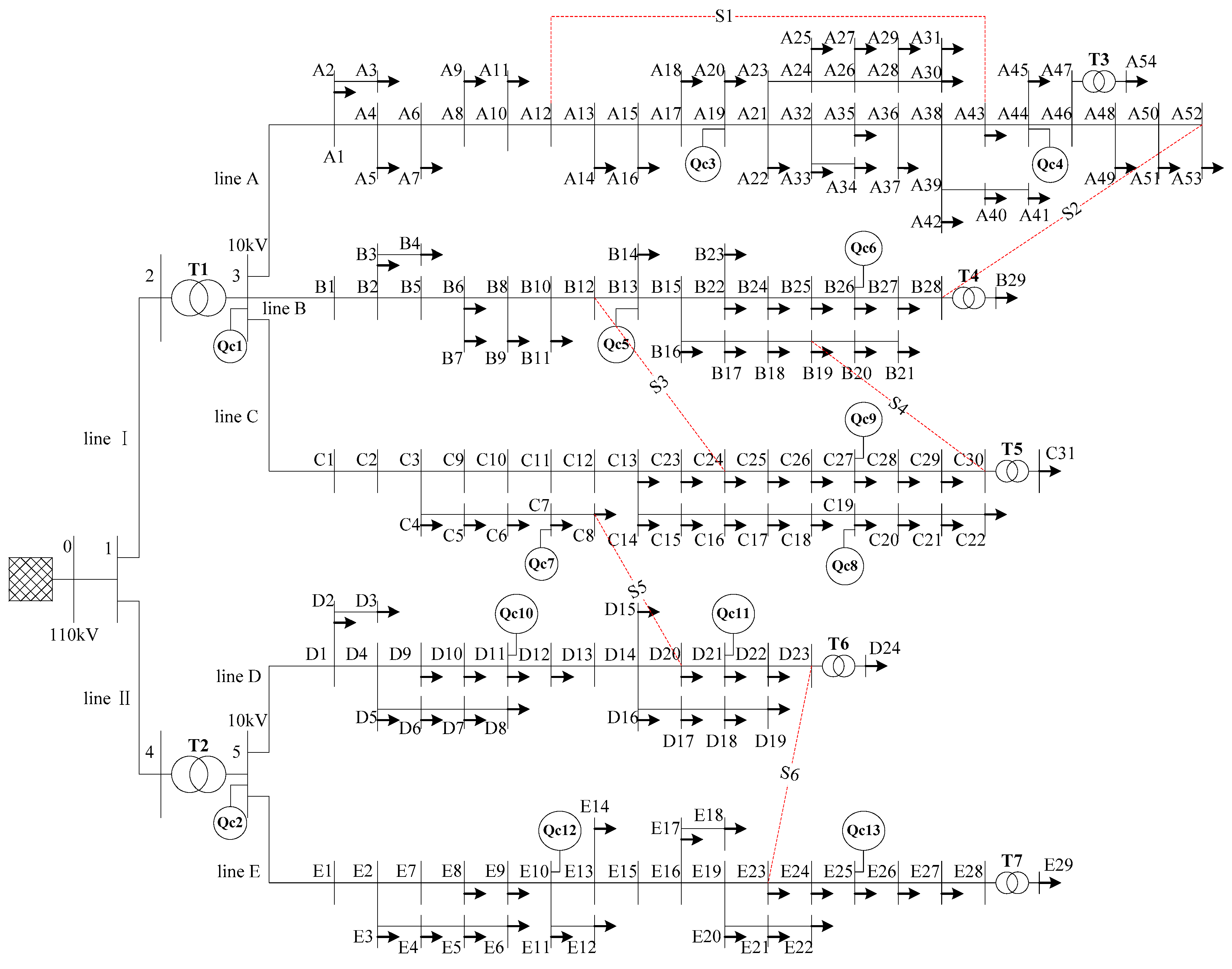
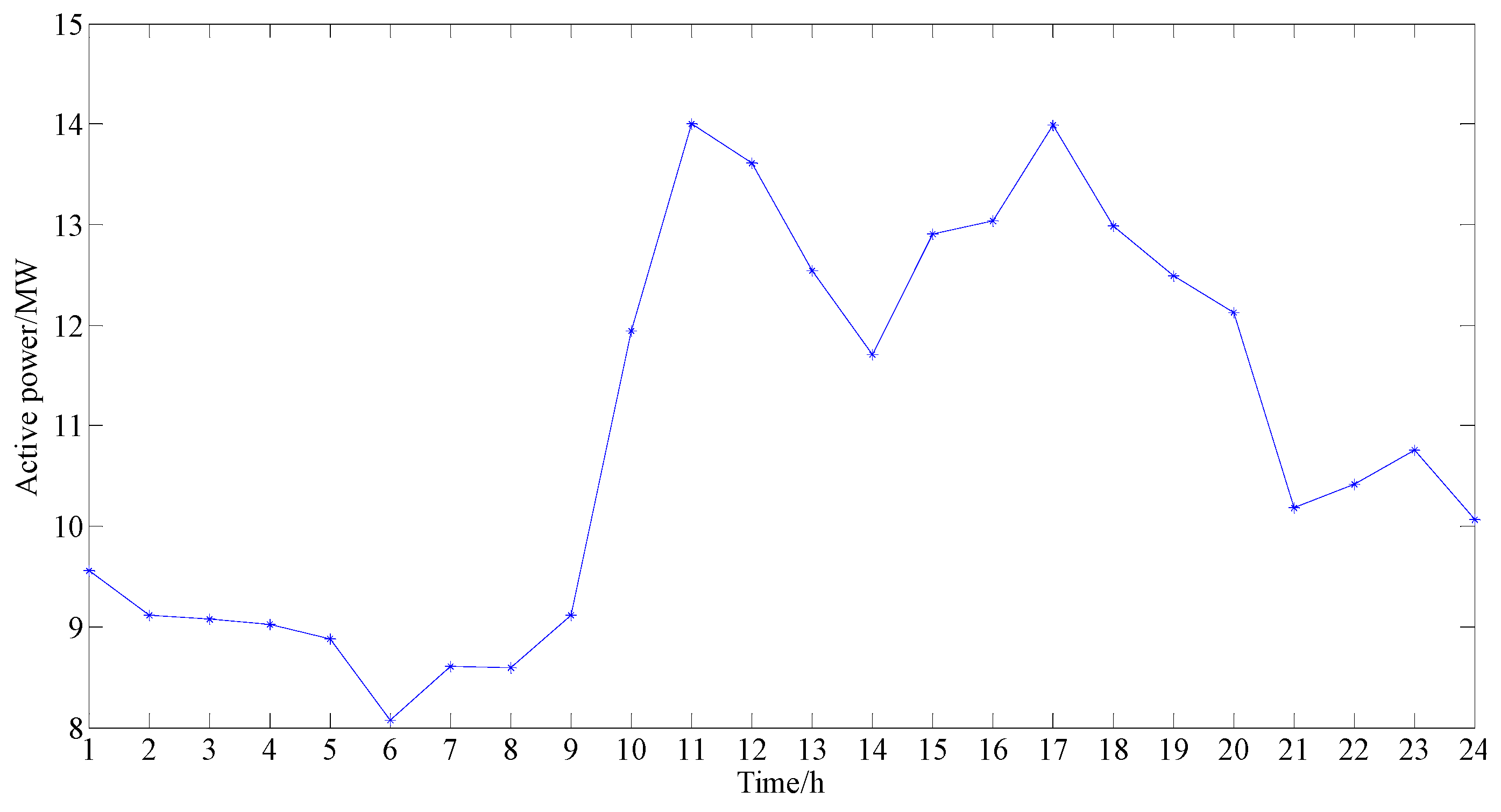
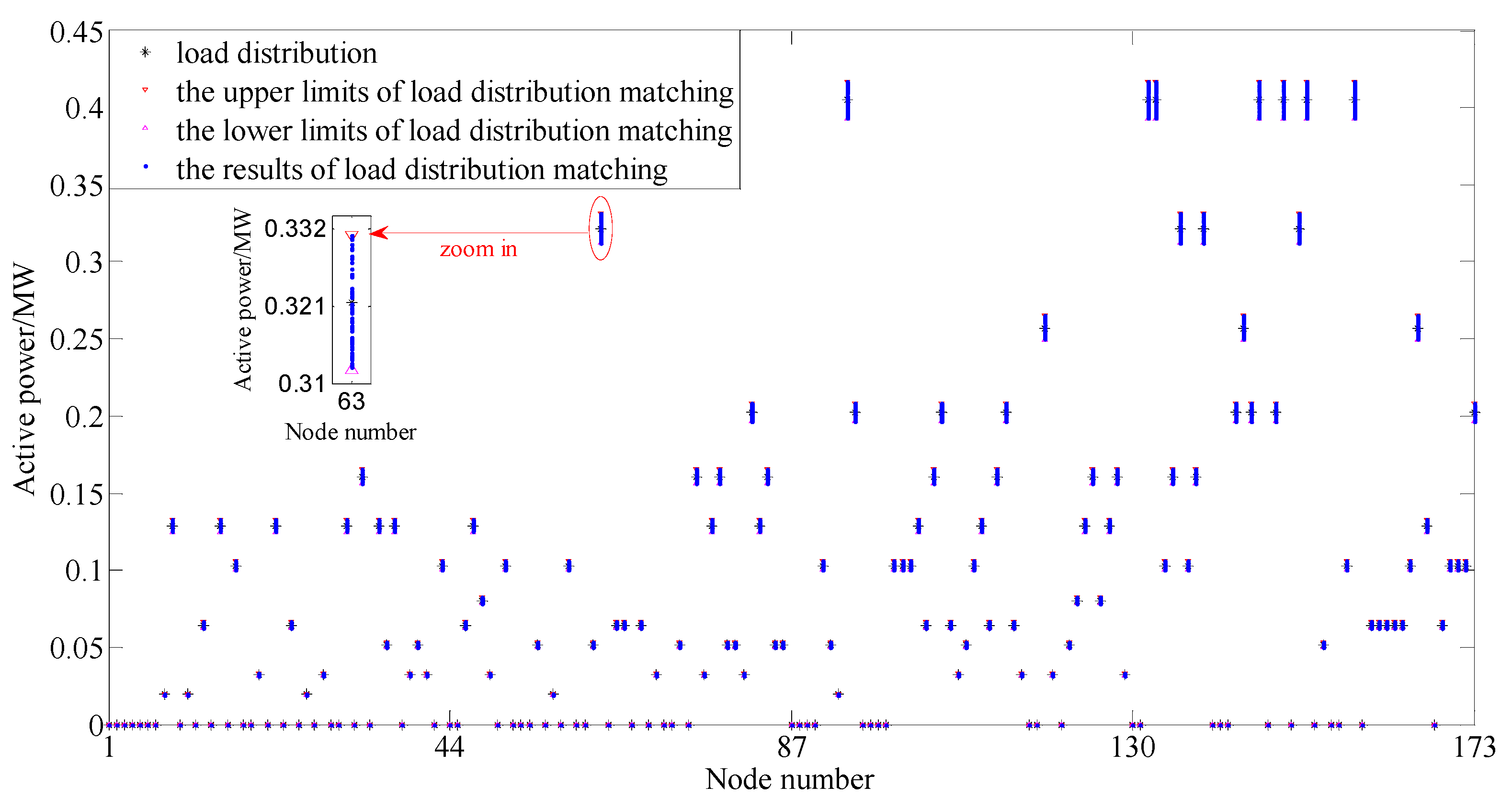

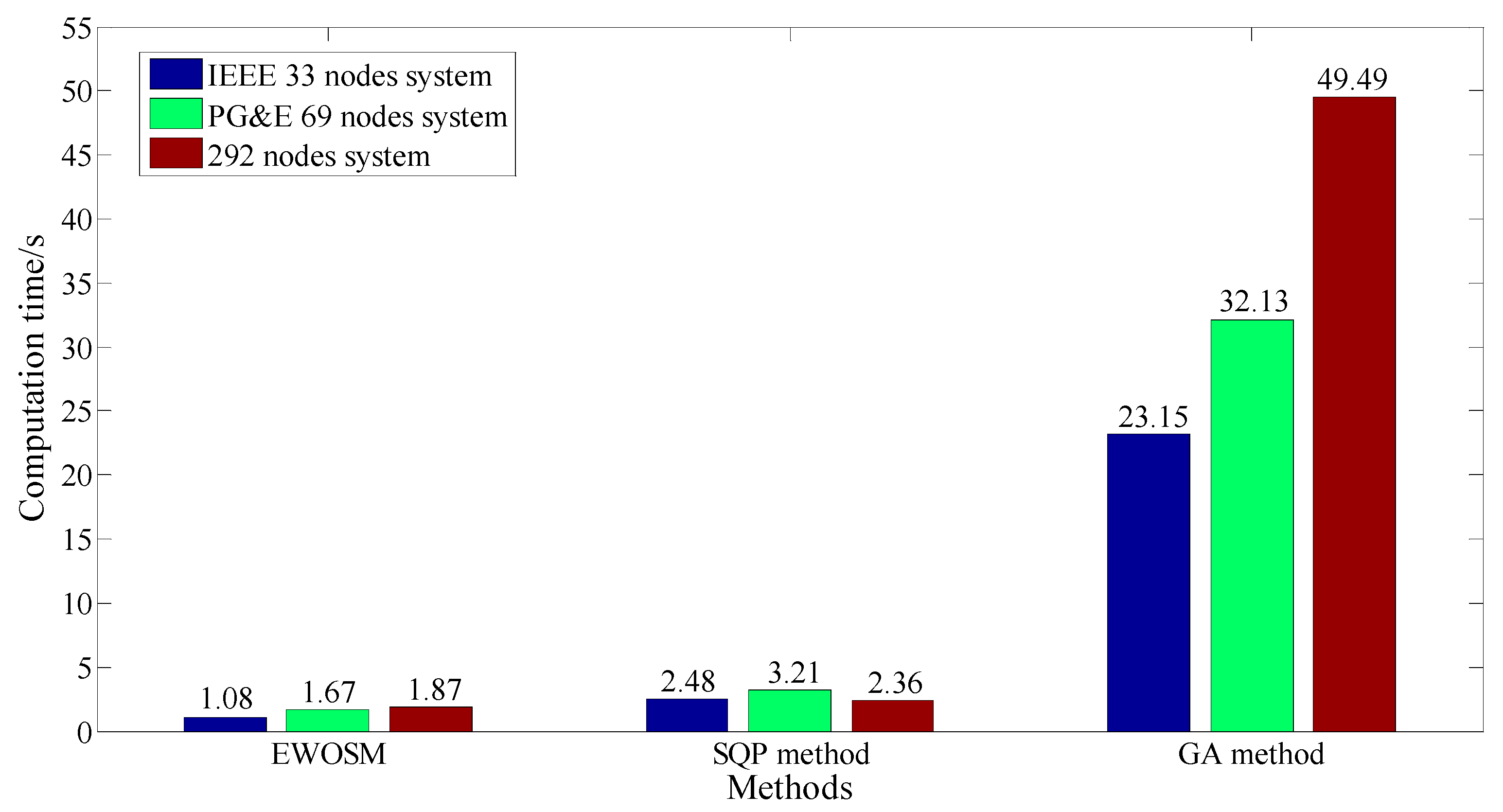
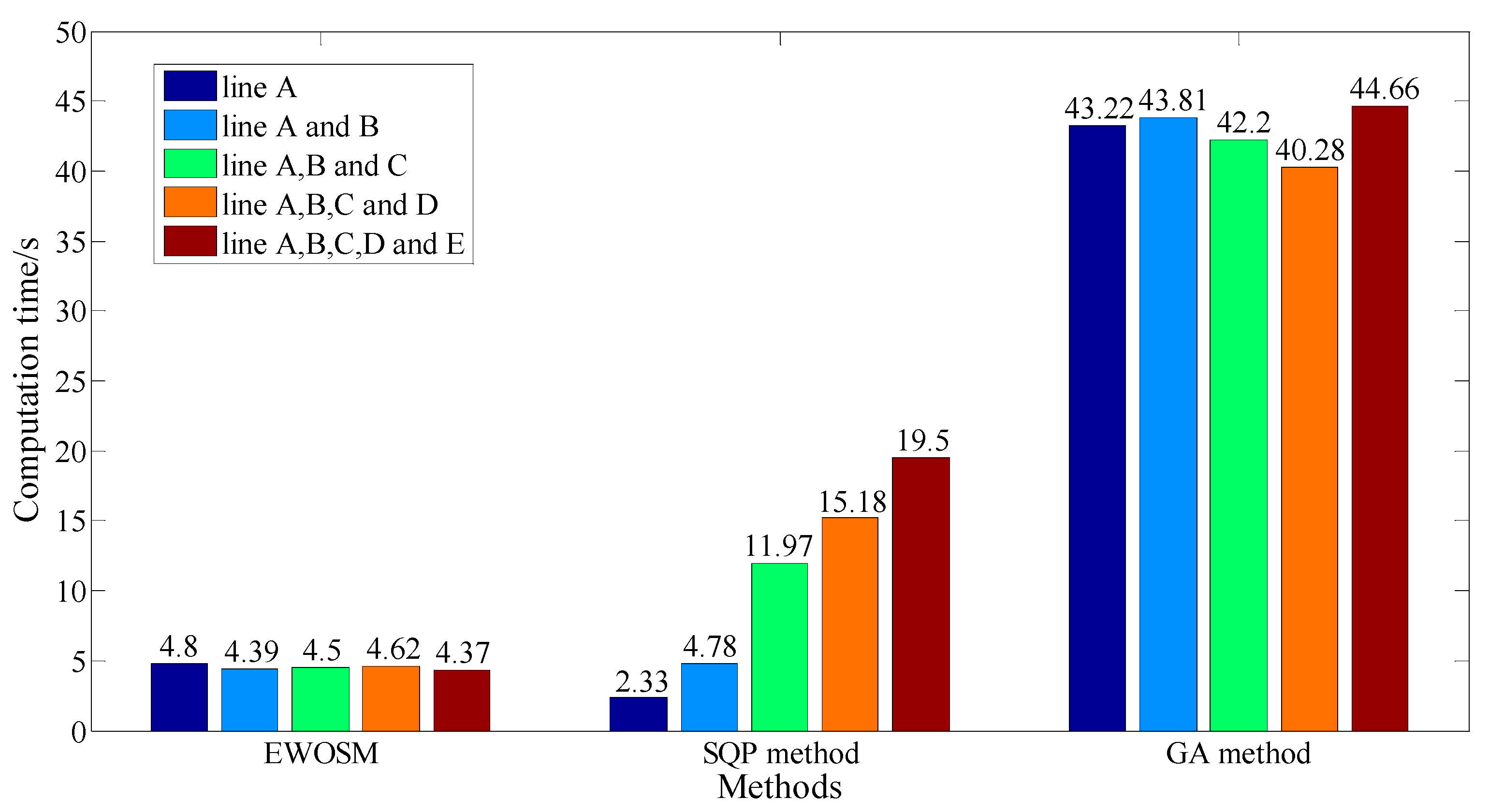
| Capacitors Name | Connected Bus Number | Compensation Capacity/Kvar | Capacitors Name | Connected Bus Number | Compensation Capacity/Kvar |
|---|---|---|---|---|---|
| Qc1 | 3 | 2000 | Qc8 | C19 | 600 |
| Qc2 | 5 | 2000 | Qc9 | C27 | 1200 |
| Qc3 | A19 | 1200 | Qc10 | D11 | 2000 |
| Qc4 | A44 | 1000 | Qc11 | D21 | 1200 |
| Qc5 | B13 | 1200 | Qc12 | E10 | 2000 |
| Qc6 | B26 | 800 | Qc13 | E25 | 800 |
| Qc7 | C7 | 600 |
| No. | The State of Tie Switches | The Disconnected Feeders | Scenario Duration/h | The Ratio of Duration | |||||
|---|---|---|---|---|---|---|---|---|---|
| S1 | S2 | S3 | S4 | S5 | S6 | ||||
| Typical topology Scenario 1 | Open | Open | Open | Open | Open | Open | / | 10,512 | 23.99% |
| Typical topology Scenario 2 | Close | Open | Close | Open | Close | Open | A12–A13, C23–C24, D14–D20 | 9744 | 22.23% |
| Typical topology Scenario 3 | Close | Close | Open | Open | Open | Close | A12–A13, A43–A44, E19–E23 | 7536 | 17.20% |
| Typical topology Scenario 4 | Open | Close | Close | Open | Close | Open | A43–A44, C23–C24, D14–D20 | 6576 | 15.01% |
| Typical topology Scenario 5 | Close | Close | Open | Close | Open | Open | A12–A13, A43–A44, B18–B19 | 2280 | 5.20% |
| Typical topology Scenario 6 | Open | Close | Close | Close | Close | Open | A43–A44, B18–B19, C23–C24, D14–D20 | 1752 | 4.00% |
| Typical topology Scenario 7 | Close | Open | Close | Close | Open | Close | A12–A13, B18–B19, C23–C24, E19–E23 | 1608 | 3.67% |
| Typical topology Scenario 8 | Close | Close | Close | Open | Close | Open | A12–A13, A43–A44, C23–C24, D14–D20 | 1560 | 3.56% |
| Sum | / | / | / | / | / | 41,568 | 94.85% | ||
| No. | The Typical Load Scenarios | The Number of Days | No. | The Typical Load Scenarios | The Number of Days |
|---|---|---|---|---|---|
| 1 | Weekday in Spring | 328 | 5 | Weekday in Autumn | 325 |
| 2 | Weekend in Spring | 132 | 6 | Weekend in Autumn | 130 |
| 3 | Weekday in Summer | 328 | 7 | Weekday in Winter | 323 |
| 4 | Weekend in Summer | 132 | 8 | Weekend in Winter | 128 |
| High Load Level (at 17 o’clock) | Middle Load Level (at 10 o’clock) | Low Load Level (at 2 o’clock) | ||||||||
|---|---|---|---|---|---|---|---|---|---|---|
| GA | SQP | EWOSM | GA | SQP | EWOSM | GA | SQP | EWOSM | ||
| Optimal schemes | Qc1/kvar | 950 | 400 | 400 | 1000 | 300 | 350 | 950 | 250 | 200 |
| Qc2/kvar | 1000 | 800 | 850 | 900 | 550 | 550 | 950 | 350 | 350 | |
| Qc3/kvar | 600 | 800 | 850 | 800 | 700 | 650 | 450 | 550 | 500 | |
| Qc4/kvar | 900 | 550 | 550 | 450 | 450 | 400 | 500 | 350 | 300 | |
| Qc5/kvar | 1050 | 950 | 1000 | 1150 | 800 | 800 | 600 | 600 | 600 | |
| Qc6/kvar | 600 | 450 | 450 | 250 | 400 | 350 | 350 | 300 | 300 | |
| Qc7/kvar | 600 | 500 | 500 | 450 | 400 | 400 | 300 | 300 | 300 | |
| Qc8/kvar | 500 | 500 | 500 | 450 | 450 | 450 | 350 | 350 | 300 | |
| Qc9/kvar | 1200 | 800 | 800 | 700 | 650 | 600 | 450 | 500 | 500 | |
| Qc10/kvar | 1900 | 1150 | 1200 | 1150 | 950 | 950 | 650 | 700 | 700 | |
| Qc11/kvar | 650 | 1150 | 1150 | 850 | 950 | 900 | 850 | 700 | 700 | |
| Qc12/kvar | 1900 | 1550 | 1650 | 1450 | 1350 | 1300 | 900 | 1050 | 1000 | |
| Qc13/kvar | 800 | 750 | 800 | 550 | 650 | 650 | 450 | 500 | 450 | |
| T1 | 1 + 6 × 1.25% | 1 + 6 × 1.25% | 1 + 6 × 1.25% | |||||||
| T2 | 1 + 6 × 1.25% | 1 + 6 × 1.25% | 1 + 6 × 1.25% | |||||||
| Network loss/kW | 637.16 | 632.86 | 631.40 | 494.76 | 494.34 | 495.39 | 342.93 | 342.11 | 342.40 | |
| Node voltage offset | 32.28 | 16.826 | 18.40 | 29.84 | 19.578 | 17.84 | 33.09 | 25.332 | 23.15 | |
| Minimum module-eigenvalue | 0.00579 | 0.00568 | 0.00569 | 0.00590 | 0.00582 | 0.00581 | 0.00606 | 0.00601 | 0.00599 | |
| Computation time/s | 44.663 | 13.64 | 4.37 | 44.29 | 10.143 | 4.846 | 39.2 | 11.497 | 3.925 | |
| No. | IEEE 33 Nodes System | PG&E 69 Nodes System | 292 Nodes System | |||
|---|---|---|---|---|---|---|
| Connected Bus | Capacity/Kvar | Connected Bus | Capacity/Kvar | Connected Bus | Capacity/Kvar | |
| Capacitors C1 | 13 | 500 | 35 | 500 | 29 | 1200 |
| Capacitors C2 | 23 | 500 | 45 | 1200 | 157 | 600 |
| Capacitors C3 | 29 | 1000 | 61 | 500 | 277 | 500 |
| The Line Participation in Reactive Power Control | The Number of Control Variables | The Specific Control Variables |
|---|---|---|
| Line A | 6 | T1, T2, Qc1–Qc4 |
| Line A and B | 8 | T1, T2, Qc1–Qc6 |
| Line A, B and C | 11 | T1, T2, Qc1–Qc9 |
| Line A, B, C and D | 13 | T1, T2, Qc1–Qc11 |
| Line A, B, C, D and E | 15 | T1, T2, Qc1–Qc13 |
| Method | EWOSM | The Hybrid Method | SQP Method |
|---|---|---|---|
| Network loss/kW | 631.40 | 632.02 | 632.75 |
| Node voltage offset | 18.40 | 17.18 | 16.71 |
| Minimum module-eigenvalue | 0.00569 | 0.00568 | 0.00567 |
| Convergence algebra | / | 9 | 42 |
| Computation time/s | 4.37 | 7.41 | 19.50 |
© 2017 by the authors. Licensee MDPI, Basel, Switzerland. This article is an open access article distributed under the terms and conditions of the Creative Commons Attribution (CC BY) license (http://creativecommons.org/licenses/by/4.0/).
Share and Cite
Ji, Y.; Liu, K.; Geng, G.; Sheng, W.; Meng, X.; Jia, D.; He, K. A Novel Reactive Power Optimization in Distribution Network Based on Typical Scenarios Partitioning and Load Distribution Matching Method. Appl. Sci. 2017, 7, 787. https://doi.org/10.3390/app7080787
Ji Y, Liu K, Geng G, Sheng W, Meng X, Jia D, He K. A Novel Reactive Power Optimization in Distribution Network Based on Typical Scenarios Partitioning and Load Distribution Matching Method. Applied Sciences. 2017; 7(8):787. https://doi.org/10.3390/app7080787
Chicago/Turabian StyleJi, Yuqi, Keyan Liu, Guangfei Geng, Wanxing Sheng, Xiaoli Meng, Dongli Jia, and Kaiyuan He. 2017. "A Novel Reactive Power Optimization in Distribution Network Based on Typical Scenarios Partitioning and Load Distribution Matching Method" Applied Sciences 7, no. 8: 787. https://doi.org/10.3390/app7080787





